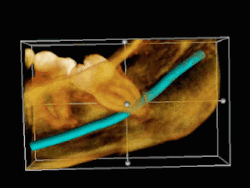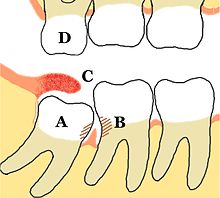Wisdom tooth
| Wisdom tooth | |
|---|---|
 Wisdom teeth | |
 | |
| Identifiers | |
| MeSH | D008964 |
| TA98 | A05.1.03.008 |
| TA2 | 911 |
| FMA | 321612 |
| Anatomical terminology | |
A wisdom tooth or third molar is one of the three molars per quadrant of the human dentition. It is the most posterior (most distal) of the three. Wisdom teeth generally erupt between the ages of 17 and 25.[1] Most adults have four wisdom teeth (a third molar in each of the four quadrants), but it is possible to have fewer or more, in which case the extras are called supernumerary teeth. Wisdom teeth commonly affect other teeth as they develop, becoming impacted or "coming in sideways". They are often extracted when this occurs.
Anatomy
Variation
Agenesis of wisdom teeth differs by population, ranging from practically zero in Tasmanian Aborigines to nearly 100% in indigenous Mexicans.[2] The difference is related to the PAX9 gene (and perhaps other genes).[3]
Function
Wisdom teeth are vestigial third molars that helped human ancestors to grind plant tissue. The common postulation [citation needed] is that the skulls of human ancestors had larger jaws with more teeth, which possibly helped to chew foliage to compensate for a lack of ability to efficiently digest the cellulose that makes up a plant cell wall. As human diets changed, smaller jaws gradually evolved, yet the third molars, or "wisdom teeth", still commonly develop in human mouths.
This article needs additional citations for verification. (November 2014) |
Clinical significance

Wisdom teeth (often notated clinically as M3 for third molar) have long been identified as a source of problems and continue to be the most commonly impacted teeth in the human mouth. The oldest known impacted wisdom tooth belonged to a European woman of the Magdalenian period (18,000–10,000 BCE).[4] A lack of room to allow the teeth to erupt results in a risk of periodontal disease and dental cavities that increases with age.[5] Only a small minority (less than 2%) of adults age 65 years or older maintain the teeth without caries or periodontal disease and 13% maintain unimpacted wisdom teeth without caries or periodontal disease.[6]

Impacted wisdom teeth are classified by the direction and depth of impaction, the amount of available space for tooth eruption and the amount soft tissue or bone (or both) that covers them. The classification structure allows clinicians to estimate the probabilities of impaction, infections and complications associated with wisdom teeth removal.[5] Wisdom teeth are also classified by the presence (or absence) of symptoms and disease.[7]
Treatment of an erupted wisdom tooth is the same as any other tooth in the mouth. If impacted, treatment can be localized to the infected tissue overlying the impaction,[8]: 440–441 extraction[9] or coronectomy.[10]

History
Although formally known as third molars, the common name is wisdom teeth because they appear so late – much later than the other teeth, at an age where people are presumably "wiser" than as a child, when the other teeth erupt.[11] The term probably came as a translation of the Template:Lang-la.
See also
References
- ^ "Wisdom Teeth". American Association of Oral and Maxillofacial Surgeons. Archived from the original on July 28, 2010. Retrieved 2010-09-28.
This generally occurs between the ages of 17 and 25
{{cite web}}: Unknown parameter|deadurl=ignored (|url-status=suggested) (help) - ^ Rozkovcová, E.; Marková, M.; Dolejší, J. (1999). "Studies on agenesis of third molars amongst populations of different origin". Sborník lékařský. 100 (2): 71–84. PMID 11220165.
- ^ Pereira, Tiago V.; Salzano, Francisco M.; Mostowska, Adrianna; Trzeciak, Wieslaw H.; Ruiz-Linares, Andrés; Chies, José A. B.; Saavedra, Carmen; Nagamachi, Cleusa; et al. (2006). "Natural selection and molecular evolution in primate PAX9 gene, a major determinant of tooth development". Proceedings of the National Academy of Sciences. 103 (15): 5676–81. Bibcode:2006PNAS..103.5676P. doi:10.1073/pnas.0509562103. JSTOR 30050159. PMC 1458632. PMID 16585527.
- ^ "Magdalenian Girl is a woman and therefore has oldest recorded case of impacted wisdom teeth" (Press release). Field Museum of Natural History. March 7, 2006. Retrieved February 15, 2013.
- ^ a b Juodzbalys, Gintaras; Daugela, Povilas (Apr–Jun 2013). "Mandibular Third Molar Impaction: Review of Literature and a Proposal of a Classification (review)". J Oral Maxillofac Res. 4 (2): e1. doi:10.5037/jomr.2013.4201. PMC 3886113. PMID 24422029.
- ^ Marciani RD (2012). "Is there pathology associated with asymptomatic third molars (review)". J Oral Maxillofac Surg. 70 (Suppl 1): 15–19. doi:10.1016/j.joms.2012.04.025.
- ^ Dodson TB (Sep 2012). "The management of the asymptomatic, disease-free wisdom tooth: removal versus retention. (review)". Atlas Oral Maxillofac Surg Clin North Am. 20 (2): 169–76. doi:10.1016/j.cxom.2012.06.005. PMID 23021394.
- ^ Newman MG, Takei HH, Klokkevold PR, Carranza FA (2012). Carranza's Clinical Periodontology. Elsevier Saunders. ISBN 978-1-4377-0416-7.
{{cite book}}: CS1 maint: multiple names: authors list (link) - ^ Pogrel MA (2012). "What are the Risks of Operative Intervention (review)". J Oral Maxillofac Surg. 70 (Suppl 1): 33–36.
- ^ Ghaeminia H (2013). "Coronectomy may be a way of managing impacted third molars (systematic review)". Evid Based Dent. 14 (2): 57–8. doi:10.1038/sj.ebd.6400939. PMID 23792405.
- ^ "Wisdom tooth". Oxford English Dictionary. Oxford: Oxford University Press. 1989. ISBN 0-19-861186-2.
